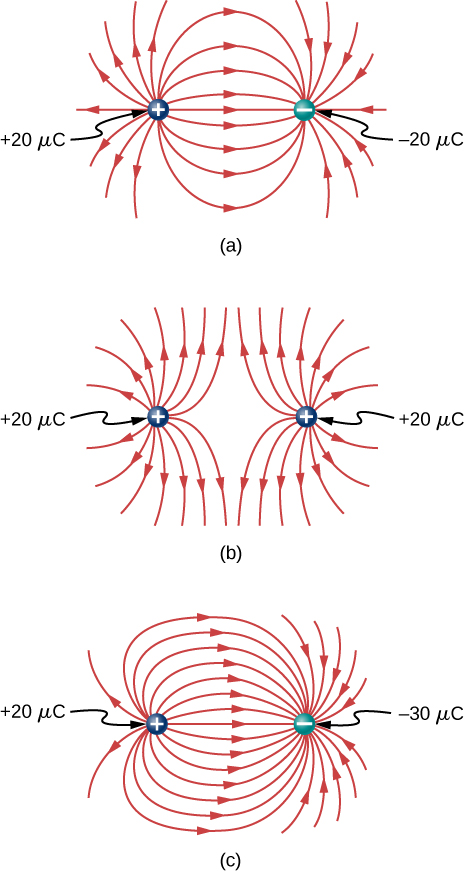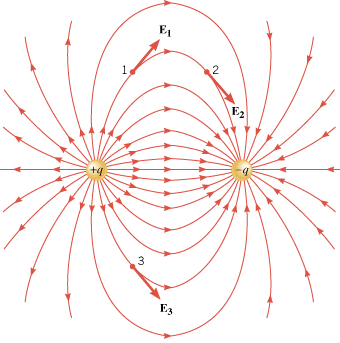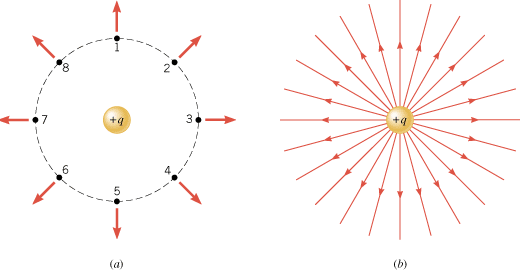This Interactive allows learners to simply drag charges - either positive or negative - and observe the electric field lines formed by the configuration of charges. 214 Chapter 5 Electric Charges and Fields.
Electric field lines due to a negative source charge come from infinity radially into and.

. Electric Field Lines Attraction and Repulsion. A charge of 2 q will have twice as many lines as a charge of q. Electric charge will flow in an electric circuit when.
A charge of 2 q will have twice as many lines as a charge of q. The number of field lines originating or terminating at a charge is proportional to the magnitude of that charge. The number of field lines originating or terminating at a charge is proportional to the magnitude of that charge.
The number of field lines originating or terminating at a charge is proportional to the magnitude of that charge. The electric field-lines associated with a positive point charge are a set of unbroken evenly spaced in solid angle straight-lines which radiate from the charge--see Fig. A series of lines drawn from a point charge representing the magnitude and direction of force exerted by that charge.
The magnitude of charge and the number of field lines both are proportional to each other. This pictorial representation in which field lines represent the direction and their closeness that is their areal density or the number of lines crossing a unit area represents strength is used for all fields. Electric field lines either originate on positive charges or come in from infinity and either terminate on negative charges or extend out to infinity.
Electric field lines about a point charge extend. Question 13 Electric field lines about a point charge extend. Thus the tangent to the field-lines is always directed radially away from the charge giving the correct direction for the electric field.
At every point in space the field vector at that point is tangent to the field line at that same point. A source of charge creates an electric field that permeates the space that surrounds. At every point in space the field vector at that point is tangent to the field line at that same point.
An electric field can be represented diagrammatically as a set of unbroken lines with arrows on which are electric field lines Rules to draw electric field lines. The direction of is tangent to the field lines the magnitude of is proportional to the number of field- lines per unit area measured in a plane normal to the lines. Outward when the charge is positive.
B The field line diagram of a dipole. The fieldvectorsnot shown here are everywhere tangent to the field lines. Electric field lines about a point charge extend outward when the charge is negative.
Figure 529 a The electric field line diagram of a positive point charge. A three-dimensional map of the electric force extended out into space from a point charge electric field lines a series of lines drawn from a point charge representing the magnitude and direction of force exerted by that charge vector a quantity. A charged balloon illustrates that something can have a great amount of.
At any point such as 1 2 or 3 the field created by the dipole is tangent to the line through the point. In both diagrams the magnitude of the field is indicated by the field line density. Use the following rules when you draw electric field lines around a point charge.
Since the electric field is a vector quantity it consists of both magnit View the full answer Transcribed image text. The use of lines of force or electric field lines ae often used to visually depict this electric field. It has been emphasized in Lesson 4 that the concept of an electric field arose as scientists attempted to explain the action-at-a-distance that occurs between charged objects.
This is acceptable probably because areal density of field lines varies as frac1r2To understand it keep a positive charge at the origin Then large number of N rightarrowinfty field lines will be emitted from that point. At every point in space the field vector at that point is tangent to the field line at that same point. Electric potential is measured in units of.
Inward when the charge is positive in circles. For a system of charges the electric field is the region of interaction. Electric field lines always point away from a positive charge and towards a.
Outward when the charge is negative. The number of field lines originating or terminating at a charge is proportional to the magnitude of that charge. The concept of th.
Electrostatic field at a point is defined as the number of field lines per unit area at that point. Electric field lines due to a positive source charge start from the charge and extend radially away from the charge to. For the field lines to either start or end at infinity a single charge must be used.
For a curved field line the electric field vector at a point is. The start point of the field lines is at the positive charge and end at the negative charge. Inward when the charge is negative.
A three-dimensional map of the electric force extended out into space from a point charge. Mathematically the electric field at a point is equal to the force per unit charge. The number of electric field.
Notice in Figure 1826 that any given. An electric field is a region around a charge where other charges can feel its influence. A charge of will have twice as many lines as a charge of.
It is a vector quantity ie it has both magnitude and direction. The electric field lines are directed away from a positive charge and towards a negative charge so that at any point the tangent to a field line gives the. The electric field strength is exactly proportional to the number of field lines per unit area since the magnitude of the electric field for a point charge is and area is proportional to.
Figure 1826 The electric field lines of an electric dipole are curved and extend from the positive to the negative charge. Drawing Electric Field Lines. Outward when the charge is positive.
A quantity with both magnitude and direction. Electric Field Lines.

Electric Field Lines University Physics Volume 2

Electric Field Lines Multiple Charges Physics

Electric Field Lines Multiple Charges Physics

The Electric Field Lines Are Directed Radially Inward Toward A Negative Point Charge

0 Comments